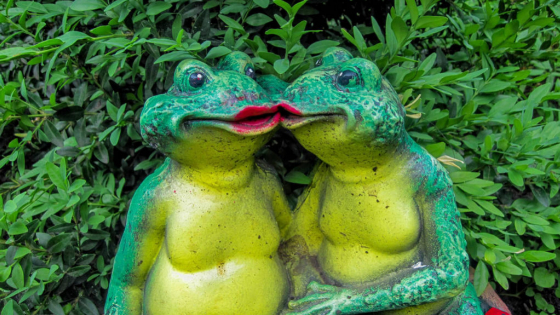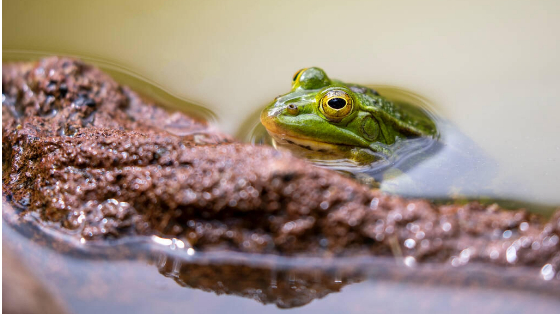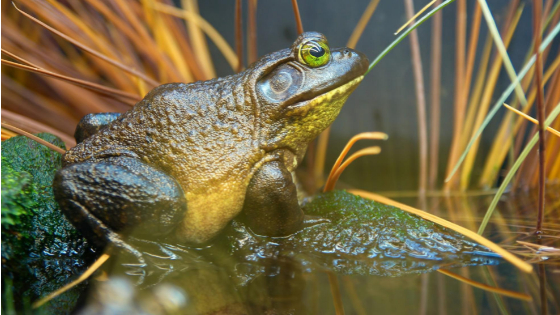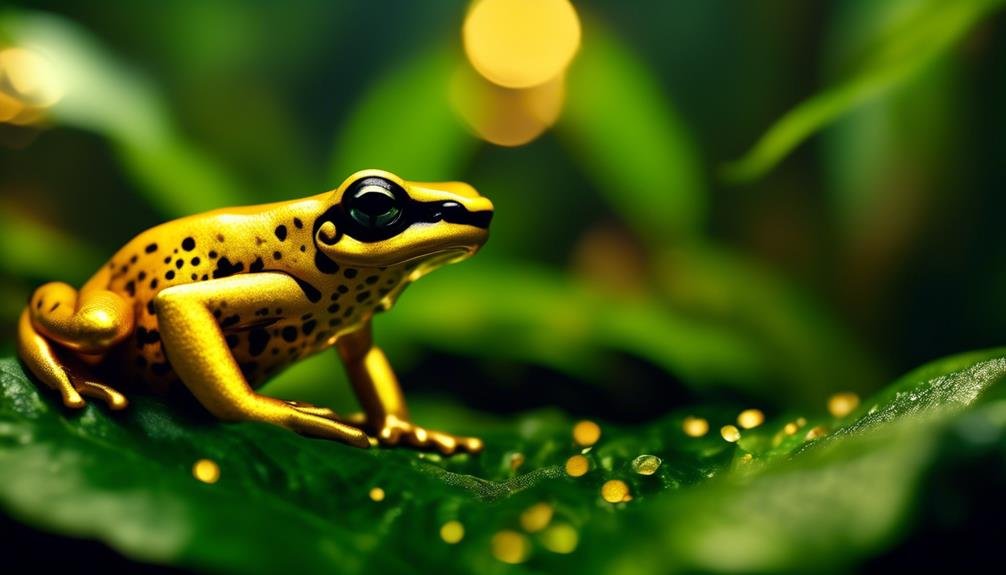
In the depths of the lush Chocó Rainforest, nestled along the Pacific coast of Colombia, resides a creature both captivating and deadly. The deadly golden poison frog, scientifically known as Phyllobates terribilis, is a toxic marvel that has intrigued scientists and enthusiasts alike. Its vibrant appearance and potent toxins have earned it a reputation that precedes its name.
But what makes this frog so fascinating? How does it navigate its environment, and what predators dare to challenge its toxicity? And perhaps most importantly, what efforts are being made to conserve this endangered species and protect its fragile habitat?
Join us as we embark on a journey into the world of the deadly golden poison frog, a creature that embodies the delicate balance between beauty and danger, and discover the secrets that lie within its toxic embrace.
Key Takeaways
- The golden poison frog, Phyllobates terribilis, is endemic to the humid forests of the Pacific coast of Colombia, specifically the Cauca and Valle del Cauca Departments in the Chocó Rainforest.
- The species is known for its deadly toxins, with the average wild golden poison frog containing enough poison to kill between 10 and 20 humans.
- Destruction of habitat has contributed to the endangered status of the golden poison frog.
- Captive breeding programs have helped decrease the demand for illegally obtained wild caught specimens, and public education and awareness campaigns aim to promote conservation and responsible pet ownership.
Taxonomy, Distribution, and Habitat
The golden poison frog, scientifically known as Phyllobates terribilis, was described in 1978 by Charles W. Myers, Borys Malkin, and John W. Daly. Its species name, terribilis, refers to the deadly toxins found in its skin secretions.
This frog is endemic to the humid forests of the Pacific coast of Colombia, specifically in the Cauca and Valle del Cauca Departments within the Chocó Rainforest. It is primarily found in primary forests, but its habitat is being destroyed, contributing to its endangered status.
The optimal habitat for the golden poison frog includes high rain rates, altitudes up to 200m, temperatures of at least 26°C, and relative humidity of 80-90%.
Description and Color Morphs
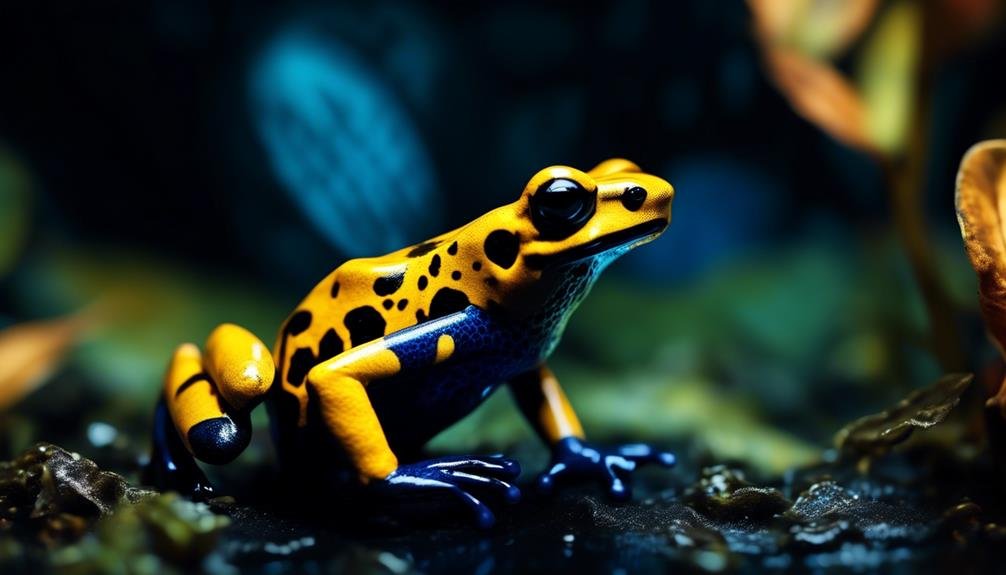
The deadly golden poison frog, Phyllobates terribilis, is not only known for its toxic skin secretions but also for its distinct description and color morphs. It is the largest species of the poison dart frog family, with adults reaching a weight of nearly 30 grams and a length of 6cm. Females are typically larger than males. The bright coloration of the adults serves as a warning to predators of their toxicity, while juveniles have black bodies with golden-yellow stripes. There are several color morphs of the golden poison frog, including the yellow morph found in Quebrada Guangui, the mint green morph found in La Brea and La Sirpa areas, and the orange morph found throughout Colombia. Additionally, there is an orange blackfoot morph with dark markings on the feet, throat, vent, and rump. The following table provides a summary of the different color morphs:
| Color Morph | Location |
|---|---|
| Yellow | Quebrada Guangui, Colombia |
| Mint Green | La Brea and La Sirpa, Colombia |
| Orange | Various locations in Colombia |
| Orange Blackfoot | Captive bred line |
These distinct color morphs contribute to the visual diversity and beauty of the golden poison frog.
Ecology and Behavior
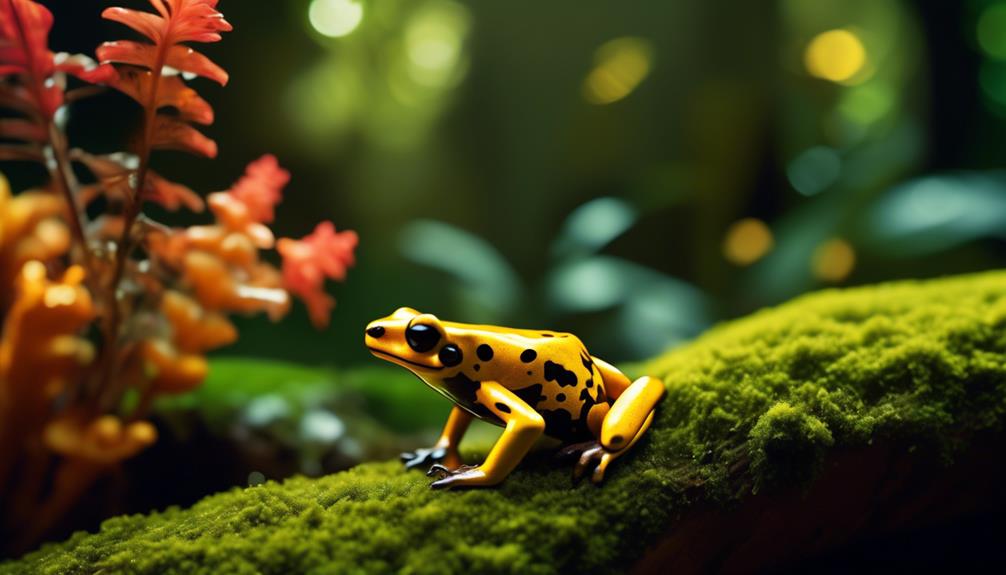
Ecology and Behavior of the deadly golden poison frog reveals its unique adaptations and interactions within its environment.
- The golden poison frog is diurnal and lives in evenly spaced territories without forming larger congregations.
- As an unspecialized ambush hunter, it preys on ants, termites, beetles, and other small invertebrates.
- During reproduction, tactile courtship takes place, with eggs being laid on the ground and tadpoles carried by adults to water-filled tree holes.
These behaviors and adaptations contribute to the frog's survival in its natural habitat.
By being active during the day, it can utilize its bright coloration as a warning signal to potential predators. Its diet of invertebrates ensures a sufficient food supply, while the unique reproductive strategy of carrying tadpoles to tree holes helps protect the offspring from predation.
Predators and Toxicity
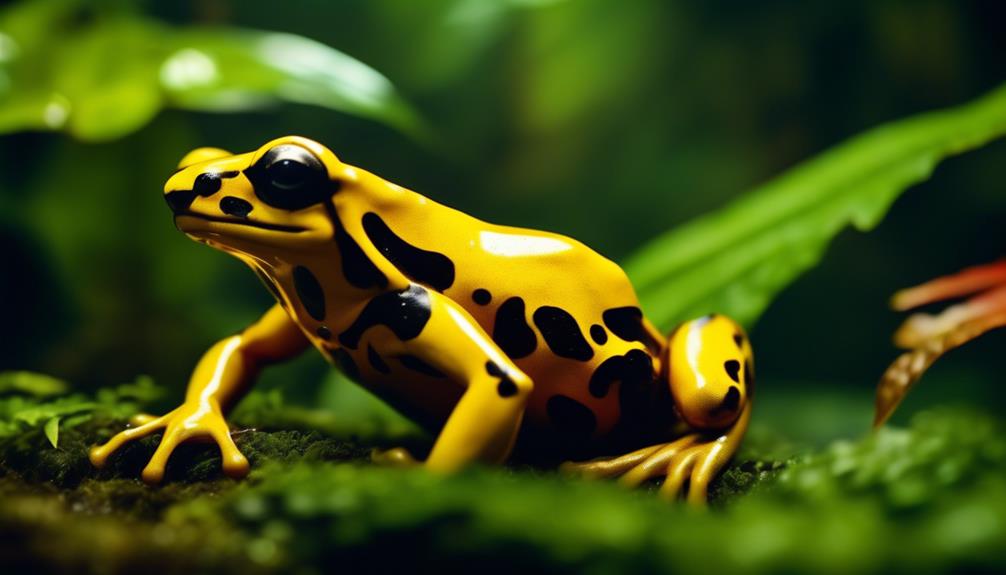
As we shift our focus to the subtopic of 'Predators and Toxicity', we now explore the remarkable defenses possessed by the deadly golden poison frog. Adult frogs have few predators due to their toxicity, but one snake species, Leimadophis epinephelus, has developed resistance to their toxins and can prey on juvenile frogs.
The golden poison frog is one of the most poisonous animals on the planet, producing deadly alkaloid batrachotoxins in its skin glands. Merely touching an individual frog can be dangerous. Batrachotoxin affects the sodium channels of nerve cells, leading to paralysis, heart failure, and death. The average wild golden poison frog contains enough poison to kill between 10 and 20 humans.
In captivity, however, specimens raised without their natural food sources are non-toxic, making them popular vivarium subjects. Conservation efforts, such as captive breeding programs, have helped decrease the demand for illegally obtained wild caught specimens.
Captivity and Conservation Efforts
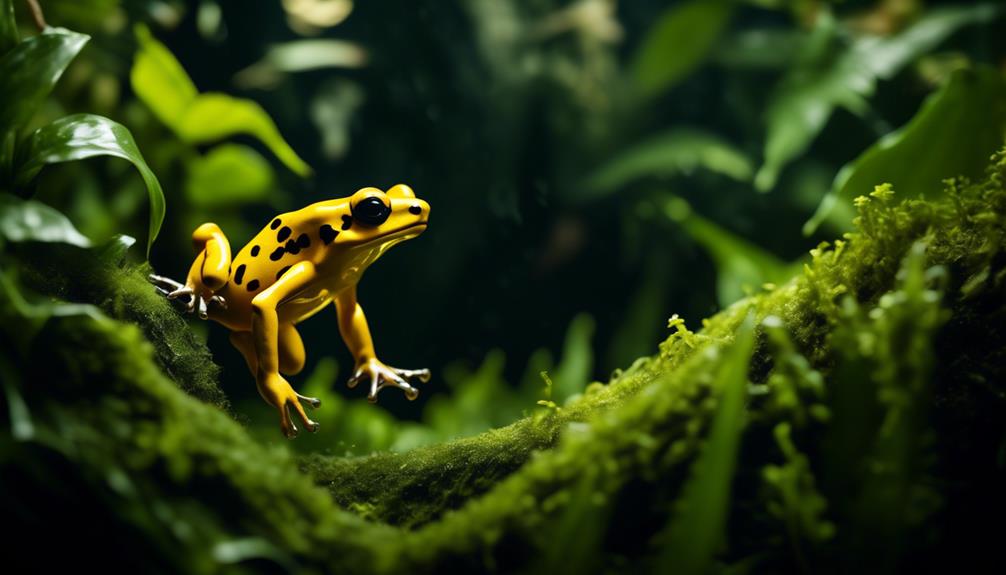
Captive breeding programs and conservation efforts have played a crucial role in protecting and preserving the golden poison frog. These initiatives have had a significant impact on the species by reducing the demand for illegally obtained wild caught specimens and promoting responsible pet ownership.
Here are three key points to consider:
- Availability of captive bred frogs: The golden poison frog is a popular vivarium subject due to its vibrant color and captivating behavior. Captive specimens raised without their natural food sources are non-toxic, making them safer for enthusiasts. The majority of golden poison frogs sold for the pet trade are now legally produced from captive lines.
- Decreased threat from poaching: The demand for illegally obtained wild caught specimens has decreased due to the availability of legal, non-toxic, and healthier captive bred frogs. Efforts by organizations like Tesoros de Colombia have contributed to breeding captive golden poison frogs for the pet trade. The International Union for Conservation of Nature (IUCN) estimates that the threat from collection for the pet trade is now small.
- Protection of natural habitat: While captive breeding programs have helped decrease the demand for wild caught specimens, efforts are also being made to protect the natural habitat of the golden poison frog. Conservation organizations and public education campaigns aim to raise awareness about the importance of preserving these habitats and promoting responsible practices.
Endangered Status and Habitat Destruction
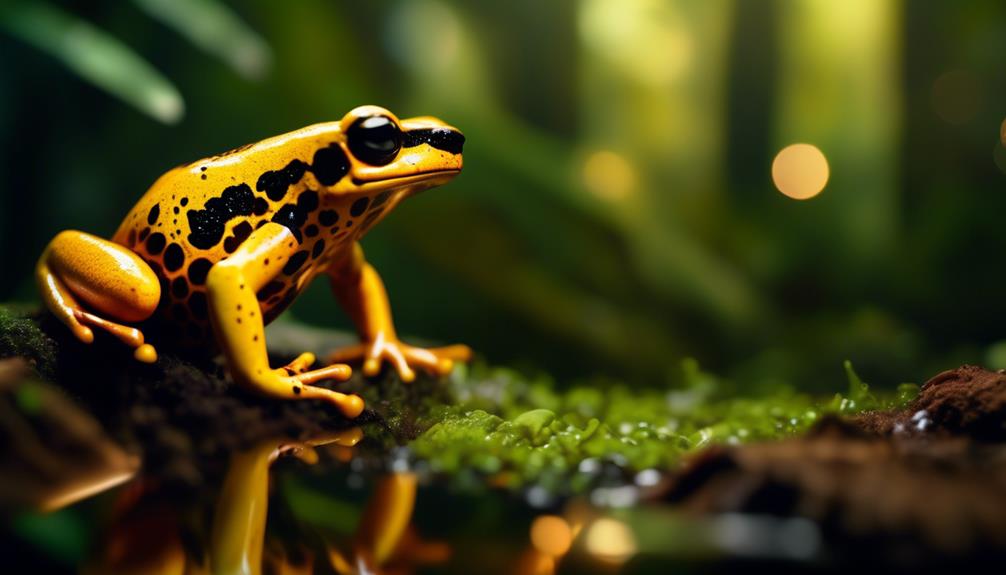
The golden poison frog faces an endangered status due to the destruction of its natural habitat. This species is endemic to the humid forests of the Pacific coast of Colombia, specifically in the Cauca and Valle del Cauca Departments in the Chocó Rainforest. The optimal habitat for the golden poison frog is a rainforest with high rain rates, altitudes up to 200m, temperatures of at least 26°C, and relative humidity of 80–90%.
However, this species is known only from primary forests, which are being rapidly destroyed by human activities such as logging and agriculture. As a result, the golden poison frog's habitat is shrinking, leading to a decline in its population and endangering its survival.
Conservation efforts are crucial to protect the remaining habitat and prevent the extinction of this toxic marvel.
Deadly Alkaloid Batrachotoxins
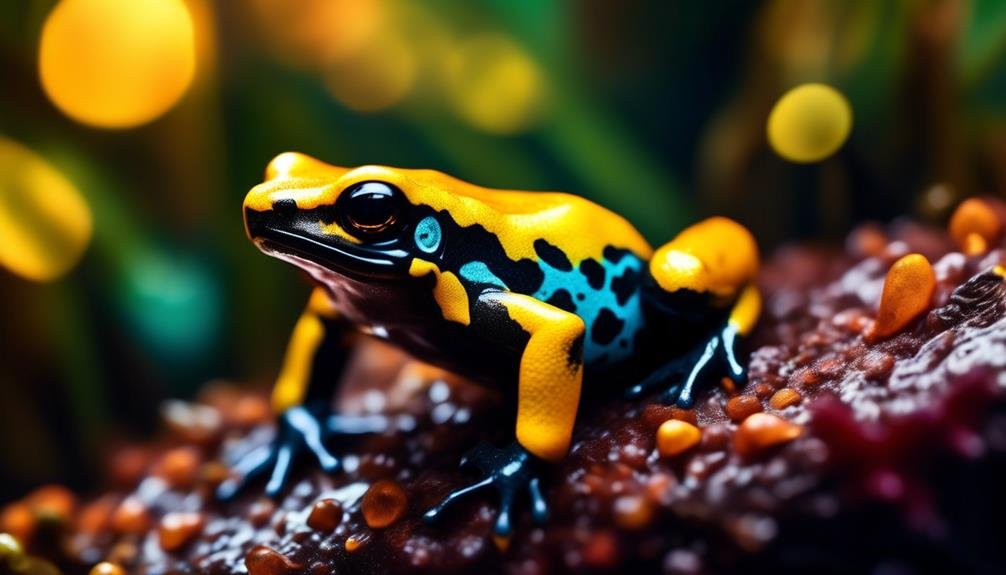
The destruction of the golden poison frog's natural habitat has led researchers to uncover the fascinating and lethal properties of its skin secretions, particularly the presence of deadly alkaloid batrachotoxins. These batrachotoxins are responsible for the frog's potent toxicity and make it one of the most poisonous animals on the planet.
Here are three key facts about deadly alkaloid batrachotoxins:
- Unique Poison: Batrachotoxins are a rare poison found only in certain frogs, birds, and beetles. They bind to and open sodium channels in nerve cells, leading to paralysis, heart failure, and death.
- Lethal Dosage: The average wild golden poison frog contains about one milligram of poison, enough to kill between 10 and 20 humans. Smaller doses can cause seizures, muscle contractions, and death in mice. The lethal dose for humans is estimated to be between 2.0 and 7.5µg.
- Cultural Use: Native Colombians have used the golden poison frog's batrachotoxins to poison blow-gun darts for hunting. The potent poison ensures a successful capture of prey.
The deadly alkaloid batrachotoxins found in the golden poison frog's skin secretions serve as a remarkable defense mechanism, highlighting the extraordinary nature of this toxic marvel.
Importance of Public Education and Awareness
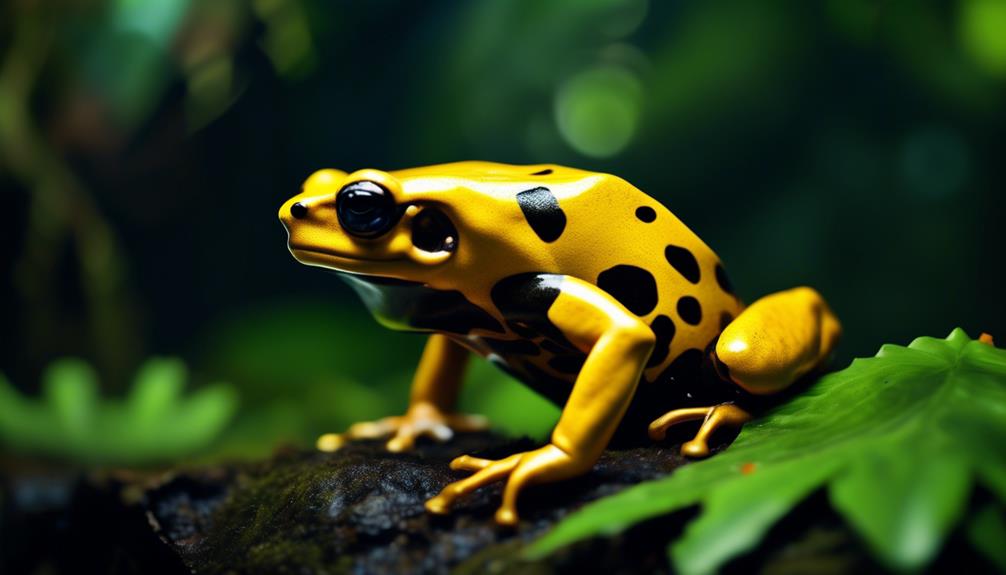
Public education and awareness play a crucial role in promoting the conservation and responsible ownership of the golden poison frog.
The golden poison frog is a fascinating and unique species that requires special care and attention.
By educating the public about the importance of preserving their natural habitat and understanding their toxic nature, we can encourage responsible pet ownership and discourage the illegal trade of wild-caught specimens.
Public education campaigns can help raise awareness about the dangers of handling these frogs without proper knowledge and precautions.
Additionally, educating people about the captive breeding programs and the availability of non-toxic, captive-bred frogs can help decrease the demand for illegally obtained specimens.
Frequently Asked Questions
How Does the Golden Poison Frog Use Its Bright Colors to Warn Predators of Its Toxicity?
The golden poison frog uses its bright colors as a warning signal to predators of its toxicity. These aposematic color patterns serve as a visual deterrent, indicating that consuming the frog would be dangerous.
Can the Golden Poison Frog Survive in Habitats Other Than Rainforests?
The golden poison frog is endemic to humid forests of the Pacific coast of Colombia and is known only from primary forests. Its optimal habitat includes rainforests with high rain rates, altitudes up to 200m, temperatures of at least 26°C, and relative humidity of 80–90%.
Are There Any Known Predators That Can Eat Adult Golden Poison Frogs Without Being Affected by Their Toxins?
There are likely few, if any, predators that can eat adult golden poison frogs without being affected by their toxins. However, the snake species Leimadophis epinephelus has resistance to frog toxins and can consume juvenile frogs.
How Do Captive Golden Poison Frogs Become Non-Toxic if They Are Not Raised With Their Natural Food Sources?
Captive golden poison frogs become non-toxic when raised without their natural food sources because their toxicity is derived from their diet of toxic ants and beetles in the wild. Without these prey items, the frogs do not produce the deadly alkaloid toxins.
What Are the Specific Steps Being Taken to Protect the Natural Habitat of the Golden Poison Frog?
Efforts to protect the natural habitat of the golden poison frog include establishing protected areas, implementing sustainable forestry practices, and promoting community-based conservation initiatives. Public education and awareness campaigns also play a crucial role in promoting conservation and responsible pet ownership.
How Does the Toxicity of Amazon Milk Frogs Compare to Deadly Golden Poison Frogs?
When it comes to toxicity, there is a stark contrast between Amazon milk frogs and deadly golden poison frogs. While Amazon milk frogs possess mild poison levels, deadly golden poison frogs are known for their highly toxic skin secretions. Both amazon milk frogs poison frogs have distinct levels of toxicity, making them fascinating creatures to study.
Conclusion
In conclusion, the deadly golden poison frog, with its vibrant appearance and potent toxins, is a remarkable species that thrives in the humid forests of Colombia.
Its toxicity, caused by batrachotoxins, makes it lethal to both predators and humans.
Efforts to conserve this endangered species and protect its natural habitat are crucial, as habitat destruction continues to threaten its survival.
Public education and awareness play a vital role in promoting the importance of preserving this toxic marvel of nature.

